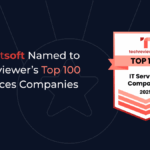As we approach 2025, businesses are facing growing pressure to implement effective IT cost reduction strategies without sacrificing performance or innovation. The widespread adoption of cloud services, escalating cybersecurity threats, and the continuous drive for digital transformation have all contributed to rising IT costs. However, with the right IT cost reduction ideas, companies can lower expenses while maintaining operational efficiency and security. We’ll explore key IT cost optimization strategies, from cloud optimization to vendor management, and provide practical insights on how to achieve meaningful IT cost savings.
Overview of IT Costs
IT costs have been steadily rising due to cloud adoption, AI investments, and increased cybersecurity demands. Nearly 66% of application software spending is projected to go toward cloud solutions by 2025, making effective cost management essential. While cloud technologies offer scalability, improper management can lead to inflated IT costs, requiring businesses to focus on reducing IT costs through optimization. According to Accenture, migrating workloads to the public cloud can result in a 30-40% reduction in Total Cost of Ownership, emphasizing the critical role cloud optimization plays in reducing costs.
AI and cybersecurity also drive expenses, with companies investing heavily in these areas to stay competitive and secure. To achieve reduce costs in IT, businesses must streamline their infrastructure, reduce expenses, optimize software licenses, and implement efficient IT cost savings ideas. Regular audits, financial management, cloud optimization, and proactive cybersecurity measures are crucial for reducing IT costs and ensuring long-term sustainability. Additionally, aligning IT expenditures with strategic business outcomes enhances business value, ensuring that every financial decision contributes to the organization’s mission and goals.
What Is the Purpose of Cost Reduction?
The main goal of IT cost oprimization is to free up resources for more strategic initiatives, such as investing in new technologies or enhancing core business operations. By reducing IT costs, companies can remain competitive and flexible, allowing for innovation and growth while maintaining their service levels and operational efficiency.
These strategies help businesses eliminate unnecessary expenses, such as redundant services or unused software, and optimize infrastructure to reduce IT running costs. By cutting waste and optimizing processes, companies can operate more efficiently, stay agile, and reinvest in areas that drive growth.
IT Audit and Categorization
Before implementing any IT optimization, businesses must first conduct a comprehensive IT audit. This audit involves a detailed review of all IT-related expenses, including hardware, software, other infrastructure assets, and services. By categorizing these costs into essential and non-essential, companies can identify areas where IT ops cost reduction strategies can be applied to streamline spending. This process helps uncover inefficiencies and allows businesses to focus on critical resources while minimizing waste, laying the foundation for more strategic IT cost reduction strategies.
One critical outcome of the IT audit is identifying inefficiencies and redundancies within the IT environment. For example, overlapping software licenses or underutilized servers often lead to unnecessary expenses. By addressing these redundancies, businesses can reduce IT costs through service consolidation and better resource management.
Assessing Current IT Expenditure
A thorough review of current IT expenditures is crucial for reducing waste and identifying where IT cost cutting measures can be applied. By analyzing spending across infrastructure, software, and services, businesses can uncover opportunities to reduce waste and achieve significant IT cost savings. For example, many organizations can reduce network costs by optimizing outdated or underutilized systems and their support costs by transitioning to more efficient, cloud-based solutions.
Software licenses are another common area for potential IT cost cutting initiatives. Many companies hold unused or redundant licenses, increasing unnecessary costs. Regular audits can help eliminate or consolidate these licenses, ensuring that businesses only pay for what they actually need. Similarly, reviewing hardware usage often reveals opportunities to replace outdated equipment or virtualize resources, leading to further savings.
Top IT Cost Reduction Methods
Implementing various IT cost reduction strategies can help businesses achieve sustainable savings without sacrificing efficiency. Below are some proven cost saving methods:
Cloud Optimization
Optimizing cloud usage is one of the most impactful IT cost savings ideas available to modern businesses. As more organizations migrate to cloud platforms, managing cloud resources effectively becomes essential for controlling their operating costs. Right-sizing cloud resources means aligning cloud capacity with actual business needs, ensuring companies aren’t paying for more than they use. This involves analyzing usage patterns, scaling resources up or down as needed, and eliminating unused or redundant services. Through cloud optimization, businesses can not only reduce IT running costs, but also improve the efficiency of their operations by making sure their resources are being used optimally.
Consolidation and Virtualization
Virtualization is a critical component of IT cost reduction strategies because it enables businesses to maximize resource utilization while minimizing infrastructure costs. By consolidating multiple physical servers into fewer virtualized environments, organizations can significantly reduce hardware, maintenance, and energy expenses. For businesses looking for how to reduce IT costs, virtualization offers a powerful solution by optimizing existing resources and cutting unnecessary spending.
Virtualization also plays a key role in reducing network overhead. By virtualizing workloads, businesses can reduce the strain on their physical data centers, which in turn lowers network management and maintenance costs. This consolidation not only streamlines IT operations but also reduces the physical footprint of data centers, contributing to lower energy consumption and IT costs.
Automation and Outsourcing
Automation is a game-changer in reducing IT costs by taking over repetitive, manual tasks that would otherwise consume valuable time and resources. Automated processes, such as software patching, network monitoring, and system backups, allow IT teams to shift their focus to more strategic initiatives, such as innovation and long-term planning. By automating routine tasks, businesses can not only reduce labor costs but also minimize errors that often arise from manual intervention, leading to higher accuracy and improved efficiency all across IT operations.
In addition to automation, outsourcing IT functions, such as software and app development, is a powerful strategy for cutting costs. By outsourcing these key areas, along with helpdesk support, infrastructure management, or cybersecurity monitoring, businesses can leverage specialized expertise at a lower cost than maintaining everything internally. Outsourcing provides access to teams with specific knowledge in technologies that may not be available in-house, allowing companies to develop advanced solutions efficiently. Together, a strong in-house team and outsourcing drive IT cost savings while maintaining operational excellence.
Software License Management
Regularly reviewing and optimizing software licenses is a powerful way to achieve IT cost cutting. Many businesses find themselves paying for unused or underutilized software licenses, leading to wasted resources. By conducting periodic audits of software usage, companies can identify opportunities to eliminate redundant licenses or reallocate them more efficiently across teams.
To further optimize software spending, businesses can leverage software license management tools. These tools provide real-time insights into how licenses are being used, helping organizations avoid overspending on unnecessary licenses and enabling them to make data-driven decisions about future software investments. By implementing effective software license management practices, companies can unlock valuable IT cost savings ideas and maximize the return on their software investments.
Energy Efficiency
Energy efficiency is an often overlooked but highly impactful area for IT cost savings. As data centers and IT infrastructure consume significant amounts of energy, businesses can achieve substantial savings by investing in more energy-efficient hardware and optimizing power usage. For example, upgrading to energy-efficient servers and storage systems can lower electricity consumption, while utilizing advanced cooling solutions reduces the energy required to maintain optimal operating temperatures in data centers.
Businesses can reduce IT costs by consolidating data centers and adopting cloud-based solutions. Moving from power-intensive, on-premise servers to energy-efficient cloud platforms cuts operational costs and supports sustainability efforts.
Improving IT Staff Productivity
Investing in IT staff productivity is one of the key factors in driving IT ops cost reduction strategies. By equipping IT teams with the right tools, technologies, and training, businesses can significantly improve their operational efficiency. For example, productivity tools that automate routine tasks, streamline communication, and enhance project management can help IT teams work faster and more effectively. When IT teams are well-equipped and trained, they are more capable of preventing costly downtime, mitigating risks, and responding to technical challenges. As a result, these productivity improvements help to reduce IT costs by minimizing delays and improving the effectiveness of IT operations across the organization.
IT Asset Management
Effective IT asset management is crucial for optimizing your IT budget and cost savings. By tracking the lifecycle of every hardware and software asset, businesses can avoid unnecessary purchases and ensure that all IT resources are being used efficiently. For instance, knowing when to retire or upgrade hardware can help companies save money and avoid the costs associated with premature replacements or maintaining outdated systems. Similarly, tracking software usage ensures that licenses are fully utilized before investing in new software.
IT asset management also helps prevent the accumulation of “ghost” assets – hardware or software that is no longer in use but still incurs costs. By maintaining an accurate and up-to-date inventory of all IT assets, businesses can make data-driven decisions about where to invest and where to cut, helping to reduce IT costs and minimize waste.
Security Measures to Avoid Costly Breaches
Data breaches can lead to severe financial consequences, making cybersecurity a priority for IT cost savings. Implementing strong security measures, such as multi-factor authentication, firewalls, and continuous monitoring, can help prevent breaches that could result in lost revenue, legal penalties, and reputational damage. Investing in proactive security solutions reduces the risk of these costly incidents and ensures that sensitive data remains protected.
Regular security audits and the use of threat detection tools are essential for maintaining a robust cybersecurity posture. By identifying vulnerabilities and addressing them before they are exploited, businesses can avoid the significant expenses associated with recovering from a breach. Proactive security measures are a critical part of any IT cost reduction strategy, as they help protect a company’s assets while minimizing the financial impact of potential cyber threats.
Vendor Management and Contract Negotiation
Effective vendor management is a significant part of successful IT cost reduction strategies. By regularly reviewing and renegotiating vendor contracts, businesses can ensure that they are getting the best possible value for the services they receive. Consolidating services under fewer vendors provides leverage in negotiations, enabling companies to secure better pricing, terms, and conditions. This one cost cutting strategy is particularly valuable in cloud services, software licensing, and IT infrastructure, where long-term contracts often account for a large portion of IT budgets.
In addition to securing better pricing, vendor management includes assessing whether current contracts align with the company’s evolving IT needs. As businesses grow or shift focus, some services may no longer be necessary, creating opportunities for IT cost savings by eliminating or renegotiating those contracts.
Measuring and Tracking ROI
Measuring and tracking return on investment is crucial for ensuring that IT cost reduction initiatives are delivering the expected results. By using data analytics tools, businesses can monitor key metrics such as uptime, resource utilization, and overall IT cost savings. These insights help assess whether IT cost cutting efforts, such as cloud optimization or software consolidation, are effectively reducing expenses.
Regularly reviewing ROI also helps identify areas where additional IT cost cutting measures may be needed or where strategies can be adjusted to get immediate value or maximize IT cost savings. This ongoing evaluation ensures that IT investments continue to provide business value and align with business goals over time.
Conclusion
Implementing IT cost reduction strategies in 2024 and beyond requires a thoughtful combination of cloud optimization, automation, and proactive asset management. By conducting thorough IT audits, businesses can identify inefficiencies, streamline operations, and eliminate redundant services. Regularly reviewing vendor contracts and negotiating better terms can further help to reduce IT costs. These strategies allow organizations to maintain or improve operational efficiency while achieving significant cost savings in IT. For example, cloud optimization not only cuts costs but also improves scalability, and automation reduces manual work, freeing up valuable IT resources for more strategic projects.
Subscribe to updates
Source link











